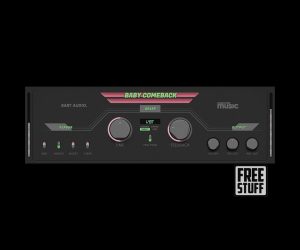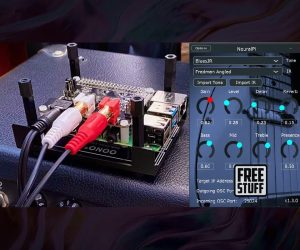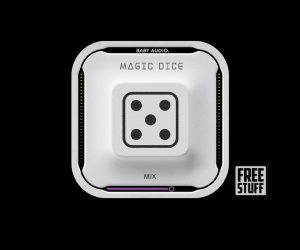
Home Grown: Recording Crowded House
What would you sacrifice to make it overseas? Your friends, family, finances and – gasp – lifestyle? Well, says successful London-based Aussie engineer Jonathan Shakhovskoy: that’s what it takes. Oh, and some good contacts don’t hurt. Here’s how he got it all – including a stint on Crowded House’s recent comeback album, Time On Earth.
Text: Gavin Hammond
Everyone at audio school dreams of hitting the big-time, working on a ‘modern classic’ in a big studio in London or L.A. and hanging out with top-line international producers… being known for a ‘sound’ that only you are trusted to create is the dream come true.
Yes, the myth and mystique of making it ‘overseas’ certainly casts a long shadow over our business, but what does it really take to be an internationally successful engineer?
Does our industry – or our audio education system – really equip you for the realities of work in the big league? Does it take years of working your way up in Australia, plotting your path to global domination as you progress from assistant tea boy to freelancer and beyond?
Is it a matter of building your own studio – and name – as you gradually lure world-class talent to your domain or getting mummy and daddy to sponsor you for a couple of years as you use their contacts to wheedle your way into the entertainment industry party by party?
Hmm, let’s ask Jonathan Shakhovskoy, who’s doing rather well over in London town. In fact, he’s possibly one of the most in-demand Aussie recording and mixing engineers in London – working with top acts, both new and established.
What’s his secret to success? Surely that’s quite a story… Wait a minute. What’s that? He moved to London shortly after finishing an audio course at ‘the Con’ in Brisbane, with virtually no real-world audio experience?
Jonathan – what is going on? Did you sign a pact with the devil or something? Talk to us!
HITTING THE ROAD
Jonathan Shakhovskoy: I decided fairly early on that if I ever wanted to be an audio engineer at the top level I’d probably have to move overseas. I wanted exposure to the artists, producers, engineers and studios that I’d read about. So it was either Los Angeles, New York or London, and since getting a work permit in the UK was a whole lot easier at the time, I opted for that.
I got to London and started at the bottom making tea and assisting on sessions. I don’t regret studying at all, but waving a degree in front of a studio manager isn’t worth a lot. One thing’s for sure though, I was glad for the large console experience with the Neve at uni because it gave me confidence when I was first confronted with an SSL. Ultimately this job is about sitting in close confines with people for long periods of time, so knowing your role in that space, being competent and, most importantly, getting along with everyone around you, is essential. It’s probably impossible to teach that in an academic environment.
I knew my way around ProTools and Logic when I left uni, but what you learn about in a studio is efficiency. There were some productions where I was cutting up 16th note hi-hats to groove with a loop on a four-minute song. That’s a lot of edits. A few times I looked in the fade files folder and it was in excess of 30,000 fades (and this is well before Beat Detective even existed).
Being fast on the computer is pretty essential, but it’s not something you learn until you have a producer peering over your shoulder waiting for you to finish – then, you’re forced to step it up a gear.

Gavin Hammond: So how did you get a break in London?
JS: After a year of being in London I still hadn’t landed a job in a studio. I had blanket bombed every studio with a CV and even entertained the notion of doing post production sound for TV, but I had no luck. I’d become friends with the very talented Katie Noonan (the singer in George and Elixir) at university and when I came back to Australia briefly after 10 months away I caught up with her and she mentioned a guy she knew who ‘knew someone who knew someone’. Four degrees of separation later I got in touch with a writer/producer back in London who took me on as his assistant.
GH: How did you progress from that first break to where you are now?
JS: He did a lot of pop work at the time, which was a great introduction to being around the creative process in a studio. However, being in a production studio meant I didn’t get much exposure to big consoles and bands, which was something I was pretty keen on. So after 12-18 months of working full-time for him I became a freelance assistant at a couple of studios, which was a fairly precarious life. Luckily, Olympic in West London needed a regular freelancer at that time, so for the next 12-18 months I was in and out of there assisting on various sessions.
From there, I slowly met other producers, writers and artists and for the next few years did a lot of pop vocal sessions with various girl and boy bands. It wasn’t the music I loved but I got pretty good at pop vocal arranging and production. Thankfully in the past two years there have been a lot more drums and guitars involved, which is much more up my street.
GH: Was it harder moving to London than you thought?
JS: I didn’t know a soul when I came here, which I found hugely liberating. I was 22 and I found the energy of London really inspiring. Not finding any music work for a year was a little demoralising at times but I had some IT experience which kept me working. You have to leave all your friends and family, move to somewhere that generally has terrible weather and start at the bottom and earn very little in a very expensive city. On paper it sounds like a daft proposition. In the end, you have to want a challenge to be here – and like it both professionally and personally.
You have to leave all your friends and family, move to somewhere that generally has terrible weather and start at the bottom and earn very little in a very expensive city.

CROWDED STUDIO
GH: More recently you worked on last year’s Crowded House project. What did you do for them?
JS: My management put me in touch with Steve Lillywhite who was looking for someone to engineer for him on the Crowded House sessions. We spoke on the phone a few times and then met on the first day of the session. Together we worked on four tracks for Time On Earth, which I engineered, he produced and we shared the mixing duties.
Steve was approached to produce four tracks for the album, the rest having been produced by Ethan Johns. We recorded and mixed all of them in Studio 1 at Rak in St John’s Wood, not too far from Abbey Road. Rak has been there since 1976 and is one of the last great privately owned tracking studios in London. They have a fantastic API console in Studio 1 that’s as old as I am and sounds superb. The live room sounds great and the control room has almost floor-to-ceiling windows onto the street, so you don’t feel too isolated from the outside world. It’s a great place to make a record.
GH: Can you talk about the gear you used for tracking?
JS: Everything was tracked through the API console except the vocals for which I used some Neve 1073s. We recorded directly to ProTools at 88.2k and laid the masters to ProTools as well. The API isn’t an in-line console so we split the inputs and the tape returns either side of the centre section. I looked after the inputs and Steve drove the monitor balance on the other half of the console.
By the end of day one, I had most of the band set up on the various inputs and used the same recording path for each mic for the rest of the session; tweaking compression and EQ as required for each song.
Steve plays a lot with the monitor balance during tracking, getting different vibes as the production progresses. He’s the first to admit complete ignorance of anything involving the computer and only ever wanted to see 24 faders’ worth of tape returns, which is an interesting discipline and a good one. I think the luxury of having almost infinite tracks on a computer stops people from making decisions.
It’s easy to forget that some of the best records ever made were done on four-track or even cut straight to acetate in mono. So while the ProTools track count generally exceeded 24 tracks, I was sub-mixing a few things internally back to the tape returns. As the production progressed certain elements were bounced down, but I always retained all the drum mics separately for options at the mix. It was good to think about it on the board as a 24-track but still retain the option of rebalancing some things at mix time.
GH: Did you record the tracks live or with lots of overdubs?
JS: It was mostly overdubbing. Because some of the songs were still evolving in production, most things actually started with Neil Finn on acoustic and we went from there. The order of the overdubs varied with the evolution of the songs. Studio 1 at Rak has a retractable wall that cuts the space in half, so we had the drums in the far section and everyone else set up in the near half. With that arrangement we could have tracked the beds live quite successfully but it didn’t evolve that way. We had a guitar line run into the control room, which was really good for guitar and bass overdubs. We would drag a pedal board into the control room and Neil Finn or Nick Seymour (and also Johnny Marr who was on the record), would rock out in front of the monitors.
It made communication a lot more fluid when there were various ideas for overdubs being considered. Most importantly, no-one prefers listening on headphones to a set of speakers, so generally most players have a better time in the control room in my experience.
GH: Do you think tracking at 88.2k is necessary – can you really hear the difference?
JS: Very simply – yes. It’s a hot topic for debate but in the end it’s completely subjective. For me, 88.2k is more open and lot a smoother in the top end. I go for 88.2 instead of 96k because it’s twice the CD sample rate and apparently the maths works out better for sample rate converting down because it’s exactly double and produces less artefacts… so I’m told! I’m definitely not saying I can hear the difference in that regard but like everything in creative technical industries, it’s a mix of theory and practice.

CROWDED MIX
GH: How do you approach your mixes?
JS: I will always prefer to mix on an analogue console with real faders. Sonically it’s always superior to ProTools mixing. It’s great to stop looking at the waveforms on screen and just think about what’s coming out of the speakers.
At the start of a mix I like to push everything up and see what’s there to start with. I get a bit familiar with the multitrack and start to form a vision in my head for where the mix should go, getting some rough balances and some general EQ and compression sorted out. If there are banks of backing vocals or the like I’ll usually try to reduce the track count by bouncing things at this point.
After that, there are certain basics to take care of, like getting the bottom end working between the kick drum and the bass, making the snare deliver like it should, and getting the vocal sitting right. There are no hard and fast rules but I will often get the drums, bass and vocals to a place that works then start adding everything in around them. I’ll usually set the mix bus EQ fairly early on in the mix but leave the compression out until I have most of the elements in place.
If there is any editing to be done, I’ll usually do it at this point when everything is in its right place. After that it’s time to turn on the mix computer and start doing fader rides.
As I mentioned, I was outputting to only 24 faders so generally all the fine detail compression and EQ was achieved in ProTools. I’m a big fan of the Waves SSL compressors and the Sonnox Oxford EQ plug-ins and they’re a regular feature on these mixes. I took the opportunity on this session to compare the Waves API EQs with those on the desk and was impressed by how good they were.
Though I generally like to sub-mix the drums through some overall EQ and compression, on this project that wasn’t possible due to the output configuration. On Don’t Stop Now the weird piano chords in the middle eight were achieved with the Voce Chorus/Vibrato plug-in.
In the analogue domain, most of the effects were run from ProTools, although we had Rak’s lovely EMT plate reverb on the send from the desk because no plug-in will ever replace the real thing.
The mix bus had an SSL C1 compressor and a GML 8200 stereo EQ over it. The only other thing that ran analogue was Neil’s vocal sound which I ran as an analogue insert on ProTools so I could still do rides post-compression. The chain was a Teletronix LA-2A, a Urei 1176, a dbx 902 and a Focusrite EQ. I used the LA-2A for colour more than compression. I had it set to ‘Limit’ but only had it tickling the vocal. In contrast, I used the 1176 a little more savagely with both the ‘4’ and ‘8’ ratio buttons pushed in and achieving around 5dB – 10dB of compression. This doesn’t work on every voice but it was a good thing in this case.
The dbx 902 is the only de-esser worth its salt; I wish someone would write a plug-in version that was as good. And though the Sonnox EQs are really good, I had a Focusrite EQ (the blue and yellow faced one) at my disposal, which was even better.
Steve has an ethos of making mix decisions as the production progresses, so by the time we actually came to mix we had a lot of the sorting out already done. I had certain sub-mix balances set up in ProTools and I would take photos of Steve’s fader balances (the API has no automation) so we could come back to each tune fairly quickly.
For each tune I would usually start the proper mix on my own, working from where we had left it in tracking. At that stage I would do ‘the basics’ as I talk about, lifting the mix up past where we had left it at tracking. Once most of the sounds are worked out I would get Steve in, and between us we would finish the mix doing final rides and tweaking any sounds as required. Steve quite enjoys doing manual rides at mix time though we put most of them into ProTools by the end of the mix. Plate reverb send changes were always done live by necessity.
FINAL PRODUCT
GH: Talk about mastering and how you felt about the finished result.
JS: Mastering is a tricky subject. Steve and I share a dislike for the ‘louder is always better’ school of mastering engineer who really work their digital limiting. I accept that for radio this might be required to a degree, but in that case I am in favour of doing a separate cut for the radio release. I was doing a road trip to somewhere recently and something from Neil Young’s Harvest album came on in the shuffle on my iPod. It wasn’t as loud as the preceding track but once I turned it up a little I loved how big the sounds were. The record sounded enormous because it retained enough of the natural dynamic range of those instruments.
You can certainly mix for loudness but I think taking a mix that is still fairly dynamic and slamming it through a digital limiter does it no favours. The mastering guys I like understand this. If you mix for loudness then they will do their loud thing, but if you mix something to have more punch and dynamic, then they will respect that and not destroy the depth of the mix by pounding it. Time On Earth was cut by Bob Ludwig at Gateway and in my experience he’s always really good. He did a good job of marrying up songs from two different producers and three different mix engineers.
















RESPONSES